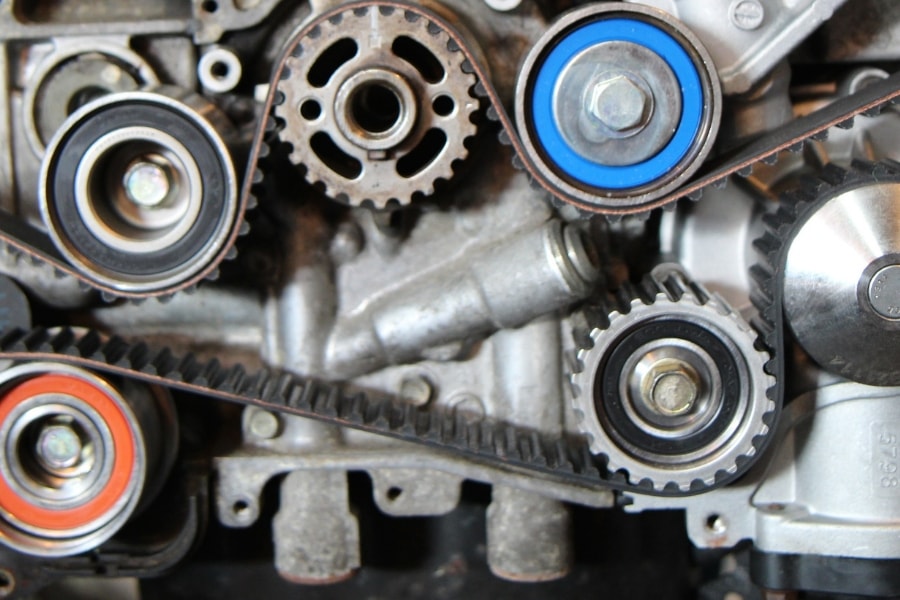
However you might have noticed some symptoms of a worn timing belt. Toyota and Lexus recommend a timing belt change every 90000 on year models that are newer than 1997.

Older style belts generally last about 50000 miles while those made from EPDM can last up to 100000 miles.
How often should you change your timing belt. Most models like those with 32-liter. Most Audis have a recommended timing belt replacement at 110000 miles. But to be on the safe side many mechanics.
If you have a cab business the probability of changing the belt may vary to six months as your car is not idle for a longer time. There isnt an exact period of time when you should change the timing belt. Replacement intervals will depend on the make and model of car with some belts lasting up to 100000 miles.
Owners of 4-cylinder Corollas from 1990 to 1997 will have a timing belt that needs to be replaced every 60k miles to avoid potential damage from a broken belt. 4-cylinder Corollas made from 1998 to today are equipped with chains so its one less replacement to think about. We recommend you replace your timing belt every four years or at around the 60000 mile mark.
However you might have noticed some symptoms of a worn timing belt. VW Timing Belt Change Intervals for Gasoline Engines 20L 8 Valve - The most recent recommend timing belt replacement interval for 20L 8 Valve models is 75000 miles. 1999-2004 VW Jetta change interval is 75000 miles for 20L 8V US A4 chassis aka Mark IV.
A timing belt typically needs to be replaced between 40000 and 100000 miles depending on the vehicle. Its a few hundred dollar repair. Its recommended that you change the timing belt in a Subaru Outback typically between 60000 miles and 90000 miles.
Subaru Outback Timing Belt Replacement Cost. Most manufacturers suggest either a time- or mileage-based change depending on which comes first. Theres a lot of variation between both manufacturers and engines when it comes to when a change is due.
This could range from 40000 miles up to 100000 miles and from four years up to six years. In terms of time this could be 4-5 or 10 years. If youre in doubt and think your timing belt might need changing consult your vehicles handbook and this will tell you how frequently it should be changed to avoid any pricey repairs.
That said the interval. Thats why its important to replace the timing belt before it slips or breaks. The schedule for timing belt replacement depends upon the make of your vehicle.
Recommended replacement intervals range between 60000 to 100000 miles. You can find this information inside your owners manual. Unfortunately in most cases there are no obvious signs the timing belt is near death.
It will just break. Thats why highly rated auto mechanics recommend replacing it every 60000 to 100000 miles. Always check your owners manual for the manufacturers recommendations.
Often times it just breaks. Thats why most manufacturers recommend you have your vehicles timing belt replaced every 60000 to 100000 miles. Refer to your owners manual to see what is recommended for your specific model.
Timing belts are replaced as part of scheduled maintenance usually every 60000 to 100000 miles. Timing belts can fail before that interval is reached but most vehicles will never have a problem with this part. If a technician notices signs of premature wear during an earlier inspection the timing belt should be replaced early.
If you are doing a timing belt job I highly recommend spending the extra time and money and replacing as much as you can all at once. You are already in there with the front end of your motor taken apart so save yourself the hassle of doing it all over again when a water pump thermostat or a gasket fails. As for changing it out most manufacturers recommend a new timing belt every 40000 to 60000 miles but there are different recommendations for different makes and models of vehicles.
Toyota and Lexus recommend a timing belt change every 90000 on year models that are newer than 1997. Older style belts generally last about 50000 miles while those made from EPDM can last up to 100000 miles. The best option is to just ensure that your car receives regular maintenance and that the belt is inspected every time.
If it breaks youll find that your driving experience is more than a little bit changed.